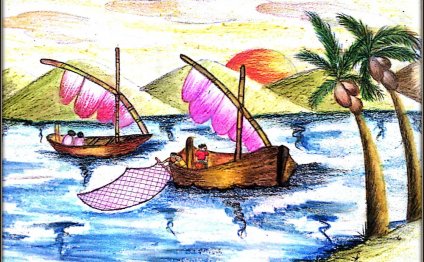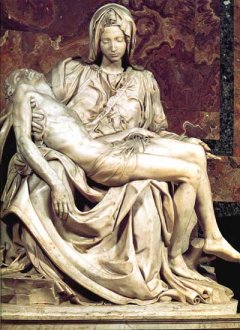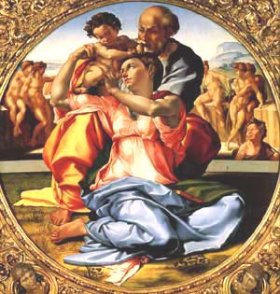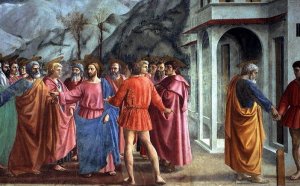
Easy Renaissance Paintings
 Michelangelo, unlike who fled the city, (Leonardo considered Savonarola to be a dangerous fanatic) was touched by the priest's teachings of morality and the promise of a rejuvenated Roman Church. However the artist decided to maintain his ties to his patrons the Medici and followed them north to Bologna. His connections with the powerful Medici paid dividends in Bologna, the young artist was introduced to and taken in by one of the city's most prominent citizens, Gianfrancesco Aldovrandi.
Michelangelo, unlike who fled the city, (Leonardo considered Savonarola to be a dangerous fanatic) was touched by the priest's teachings of morality and the promise of a rejuvenated Roman Church. However the artist decided to maintain his ties to his patrons the Medici and followed them north to Bologna. His connections with the powerful Medici paid dividends in Bologna, the young artist was introduced to and taken in by one of the city's most prominent citizens, Gianfrancesco Aldovrandi.
On Gianfrancesco's recommendation Michelangelo was given the task of carving three statuettes for one of Bologna's most famous artistic monuments, the Tomb of St Dominic. The tomb was left unfinished by the death of Niccolo del Arca in 1492. The young sculptor's contribution to this giant of a tomb are the Angel with a candlestick, and the saints Petronius and Proculus. The completed work on these three pieces had been produced in a little under a year. It was in 1496 that a marble of cupid (now lost) by Michelangelo was sold as an ancient piece to Cardinal Raffaele Riario. The cardinal discovered the fraud but was so impressed by the quality of the carving that he invited the artist to Rome.
Rome.
Cardinal Riario was the most powerful and richest man in Rome, only the Pope himself had more power and influence. Michelangelo was given a block of marble to work with and between 1496 and 1497 produced his statue of Bacchus. The Cardinal was unimpressed and rejected the work. The rejected statue came into the possession of the Roman banker Jacopo Galli. It was through this connection that the artist received a commission from the powerful French Cardinal, Jean de Bilheres, the Pieta.
 The great man considered himself to be a sculptor an architect and a poet and in 1497 he received the commission for one of his most famous works the Pieta, housed at St Peter's in the Vatican city. Michelangelo had personally visited the marble quarries at Carrara to select and supervise the quarrying of the marble block. His attention to detail paid off, the marble Pieta is of the finest quality.
The great man considered himself to be a sculptor an architect and a poet and in 1497 he received the commission for one of his most famous works the Pieta, housed at St Peter's in the Vatican city. Michelangelo had personally visited the marble quarries at Carrara to select and supervise the quarrying of the marble block. His attention to detail paid off, the marble Pieta is of the finest quality.
"Pieta". St Peters Basilica in the Vatican.
(photo by Stanislav Traykov under free licence Wikimedia Commons).
It has often been stated that Michelangelo had the ability to visualise the finished sculpture simply looking at the block of stone in front of him. When you gaze upon the Rome Pieta the story becomes totally believable. The work was carved and completed in 1499 when the artist was only 24 years old.
Back to Florence.
Returning to Florence in 1500 he began work on perhaps the most recognizable statue in art, the carving of David (completed in 1504) depicting the moment he decides to battle Goliath. This work, created from marble quarried from the famous site at Carrara, established the sculptor as an outstanding master of his time, all before his 30th birthday.
With the triumph of the David still fresh, Michelangelo was commissioned by Piero Soderini, statesman of the Republic of Florence, to produce a fresco for the Florentine state hall in Palazzo Vecchio. The chosen subject was the work never progressed beyond the cartoon stage, even so it influenced generations of artists who admired and copied it.
After the completion of the Rome Pieta and the Florentine statue of David the artist's fame was assured. He was never again short of commissions and his financial future was secured with the purchase of various properties in and around Florence.
Pope Julius II invited the artist back to Rome and commissioned him to work on a tomb worthy of the Pope's standing as the overlord of Christendom. The massive scale of this enterprise was never realised but was scaled down and is located in the Church of Pietro in Vincoli in Rome.
 Michelangelo was regarded as arrogant and short tempered and, disappointed by the scaling down of the tomb, returned to Florence and wrote a rude letter to the Pope saying that if he wanted him, he could go out and look for him. Considering that Julius II was totally ruthless this letter could have been considered a rather rash and costly mistake, however, the Pope did not lose his temper but contacted the leaders of Florence in an attempt to persuade the sculptor to return to Rome. The head of the city of Florence gave the artist a letter of recommendation stating that the young artist's skill was unequalled throughout Italy and he was soon back in the pope's service.
Michelangelo was regarded as arrogant and short tempered and, disappointed by the scaling down of the tomb, returned to Florence and wrote a rude letter to the Pope saying that if he wanted him, he could go out and look for him. Considering that Julius II was totally ruthless this letter could have been considered a rather rash and costly mistake, however, the Pope did not lose his temper but contacted the leaders of Florence in an attempt to persuade the sculptor to return to Rome. The head of the city of Florence gave the artist a letter of recommendation stating that the young artist's skill was unequalled throughout Italy and he was soon back in the pope's service.
The painting was commissioned by Agnolo Doni from the wealthy Florentine family, probably to comemerate his marriage to Maddalena Strozzi.
A Tondo is the Italian name for a circular piece of work.
When you consider that Michelangelo considered himself to be a sculptor, not a painter, this is a remarkable early work. It is his only surviving, finished panel painting.
Just look at quality of the drapery expertly executed by the artist. The array of heads and arms combine forming traditional triangles resulting in a very pleasing composition.
The Sistine Chapel.
A chapel in the Vatican had been built by Pope Sixtus IV, and is therefore called the, this was the next great commission given to Michelangelo. The walls had been decorated by famous painters of the past and the pope wanted the vault of the chamber painted to complete the decoration of the chapel. This work, lasting for four years, was completed with the artist having to lie on his back and paint looking upwards. The work contains over 300 figures and centres on the Book of Genesis, it remains one of the finest examples of one man's physical, intellectual and artistic achievement.
The Creation of Adam, from the ceiling of The Sistine Chapel. (w)
Michelangelo was commissioned by Pope Leo X to build a family funeral chapel for the Medici in the basilica of San Lorenzo one of the largest churches in Florence. In this project the artist created both the sculptures and the plan for interior. In the 1530s the artist left Florence and returned to Rome.
on the altar wall of the Sistine Chapel began in 1534, twenty years after the painter had finished the vault, took the artist seven years to complete. The massive fresco was unveiled in a ceremony on October 13th 1541 but the pictures of naked bodies on display in the chapel was considered to be obscene. The pope resisted calls for the fresco to be removed, however it was decided that the genitals should be covered, a work undertaken by Daniele da Volterra an apprentice of the great artist.
Perhaps Michelangelo least well-known paintings can be found in a chapel within the Vatican complex, The Pauline Chapel. This series of frescoes, commissioned by Pope Paul III, are sometimes considered to be inferior to the more famous Sistine Chapel works. The two works completed for the Chapel are, The Conversion of Saul and The Crucifixion of St Peter. These paintings did not follow the conventions of composition of the time but they do need to be viewed from within the long narrow chapel to see them at their best.
YOU MIGHT ALSO LIKE
![Oil Pastels [Workshop 1] – Painting Drawing Workshops](/img/video/oil_pastels_workshop_1_painting_drawing.jpg)


Share this Post
Related posts
Renaissance Paintings images
I recently completed a book that includes photos of Medieval and Renaissance artworks. Although the paintings are out of…
Read MoreRenaissance Paintings and Artists
Video: Renaissance Art: Artists, Paintings, Sculptures & Architecture In this lesson, we will be discussing Renaissance…
Read More





